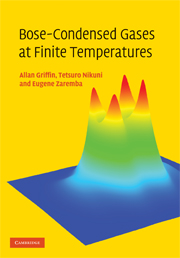Book contents
- Frontmatter
- Contents
- Preface
- 1 Overview and introduction
- 2 Condensate dynamics at T = 0
- 3 Coupled equations for the condensate and thermal cloud
- 4 Green's functions and self-energy approximations
- 5 The Beliaev and the time-dependent HFB approximations
- 6 Kadanoff–Baym derivation of the ZNG equations
- 7 Kinetic equation for Bogoliubov thermal excitations
- 8 Static thermal cloud approximation
- 9 Vortices and vortex lattices at finite temperatures
- 10 Dynamics at finite temperatures using the moment method
- 11 Numerical simulation of the ZNG equations
- 12 Simulation of collective modes at finite temperature
- 13 Landau damping in trapped Bose-condensed gases
- 14 Landau's theory of superfluidity
- 15 Two-fluid hydrodynamics in a dilute Bose gas
- 16 Variational formulation of the Landau two-fluid equations
- 17 The Landau–Khalatnikov two-fluid equations
- 18 Transport coefficients and relaxation times
- 19 General theory of damping of hydrodynamic modes
- Appendix A Monte Carlo calculation of collision rates
- Appendix B Evaluation of transport coefficients: technical details
- Appendix C Frequency-dependent transport coefficients
- Appendix D Derivation of hydrodynamic damping formula
- References
- Index
7 - Kinetic equation for Bogoliubov thermal excitations
Published online by Cambridge University Press: 06 October 2009
- Frontmatter
- Contents
- Preface
- 1 Overview and introduction
- 2 Condensate dynamics at T = 0
- 3 Coupled equations for the condensate and thermal cloud
- 4 Green's functions and self-energy approximations
- 5 The Beliaev and the time-dependent HFB approximations
- 6 Kadanoff–Baym derivation of the ZNG equations
- 7 Kinetic equation for Bogoliubov thermal excitations
- 8 Static thermal cloud approximation
- 9 Vortices and vortex lattices at finite temperatures
- 10 Dynamics at finite temperatures using the moment method
- 11 Numerical simulation of the ZNG equations
- 12 Simulation of collective modes at finite temperature
- 13 Landau damping in trapped Bose-condensed gases
- 14 Landau's theory of superfluidity
- 15 Two-fluid hydrodynamics in a dilute Bose gas
- 16 Variational formulation of the Landau two-fluid equations
- 17 The Landau–Khalatnikov two-fluid equations
- 18 Transport coefficients and relaxation times
- 19 General theory of damping of hydrodynamic modes
- Appendix A Monte Carlo calculation of collision rates
- Appendix B Evaluation of transport coefficients: technical details
- Appendix C Frequency-dependent transport coefficients
- Appendix D Derivation of hydrodynamic damping formula
- References
- Index
Summary
In Chapter 6, we derived a generalized Gross–Pitaevskii condensate equation which is coupled to a kinetic equation for the distribution function for the thermal atoms. However, the kinetic equation in Chapter 6 is only valid in the semiclassical limit. It involves the assumption that the thermal energy kBT is much greater than the spacing between the harmonic trap energy levels (kBT ≫ω0 where ω0 is the trap frequency) and also much greater than the average interaction energy (kBT ≫ gn). The ZNG model, based on HF excitations, is still expected to be adequate down to quite low temperatures in trapped Bose gases, as will be shown by the results in Chapter 12. However, the ZNG model will break down at very low temperatures, where the Hartree–Fock excitations must be replaced by the Bogoliubov spectrum. To deal with this, one has to derive a kinetic equation for the Bogoliubov quasiparticle excitations. This is the goal of the present chapter.
In this chapter, we use the second-order Beliaev approximation to discuss the nonequilibrium dynamics of a trapped Bose-condensed gas at finite temperatures. In doing to, we combine the second-order Beliaev self-energies with the lower-order Bogoliubov excitation spectrum, including off-diagonal single-particle propagators but still omitting the anomalous correlation functions. This last condition defines the Bogoliubov–Popov approximation. In this chapter, we consider only the damping which arises from collisions. We will not explicitly calculate corrections that are second-order in g to the quasiparticle energy spectrum or to the condensate chemical potential, both of which are associated with the real parts of the second-order Beliaev self-energies.
The present chapter is a natural generalization of work presented in Chapter 6 for the simpler HF excitation spectrum assumed in the ZNG analysis.
- Type
- Chapter
- Information
- Bose-Condensed Gases at Finite Temperatures , pp. 129 - 145Publisher: Cambridge University PressPrint publication year: 2009



